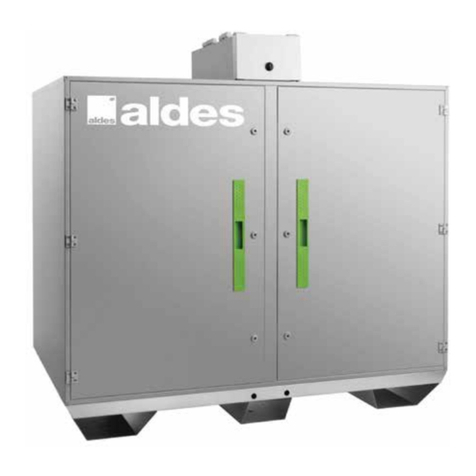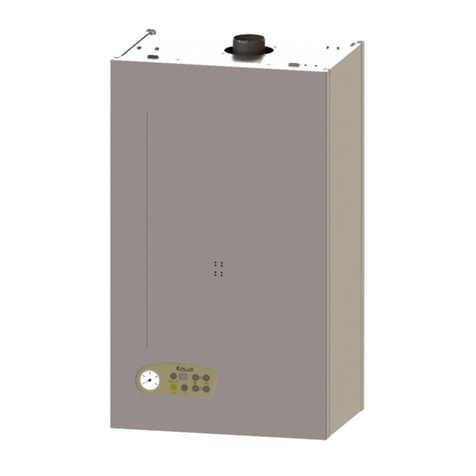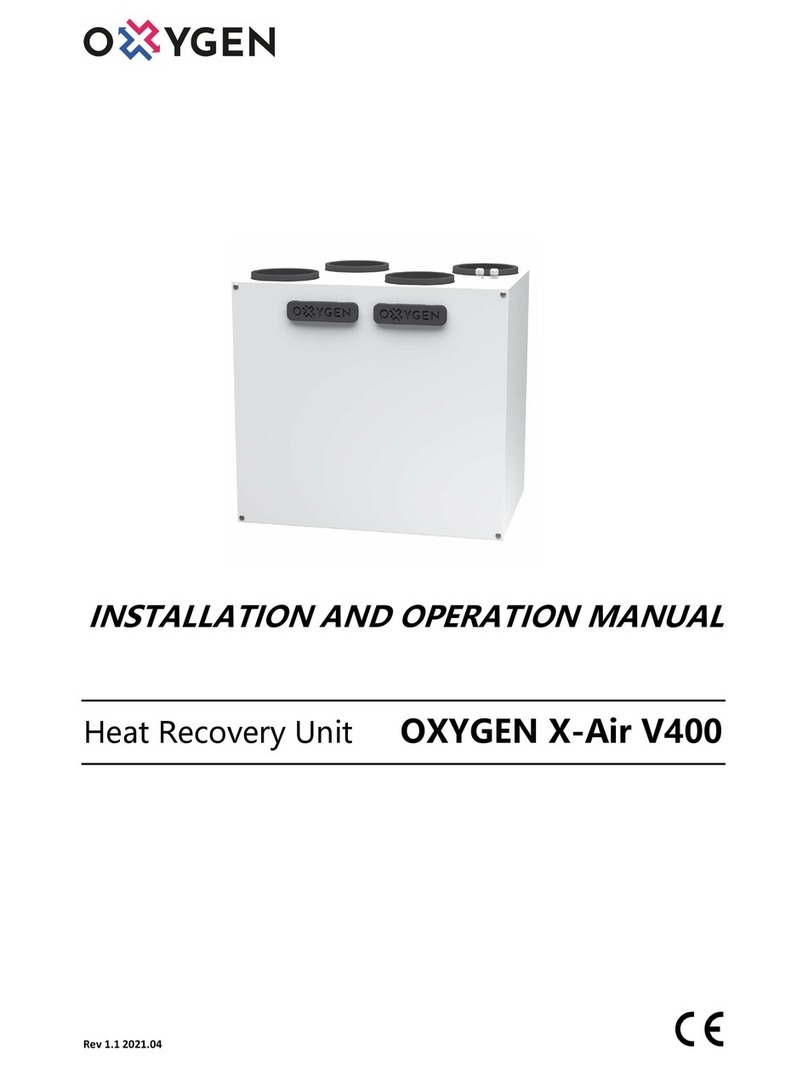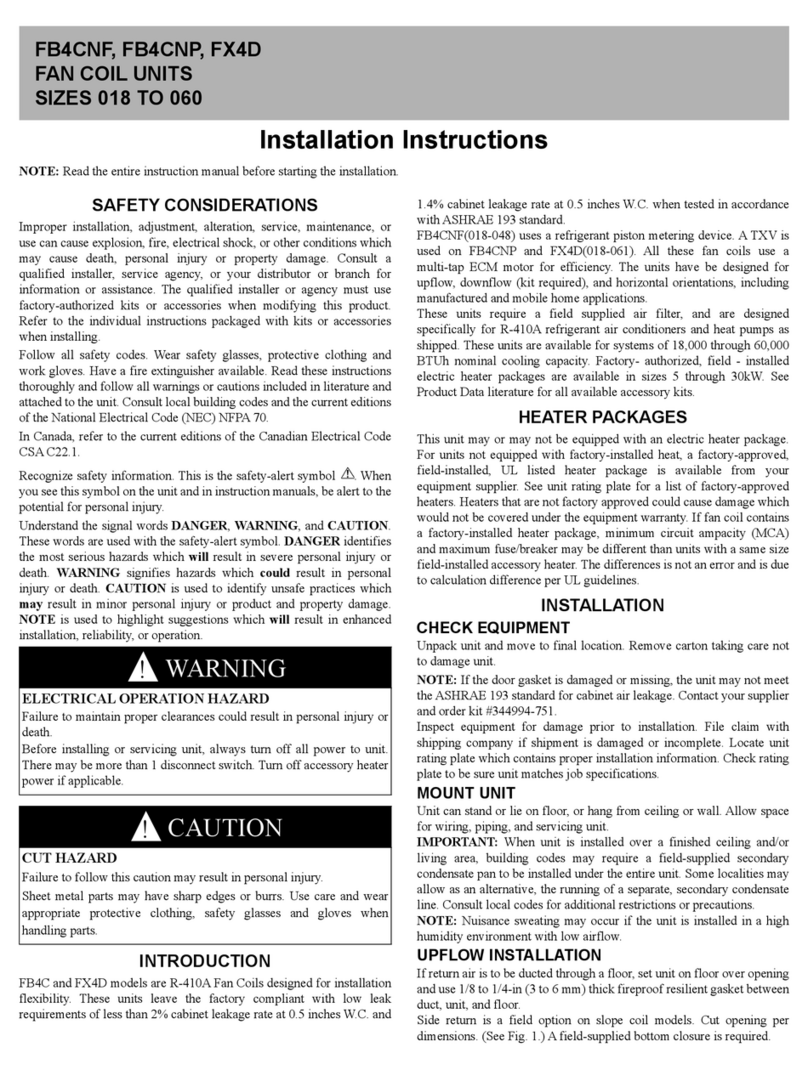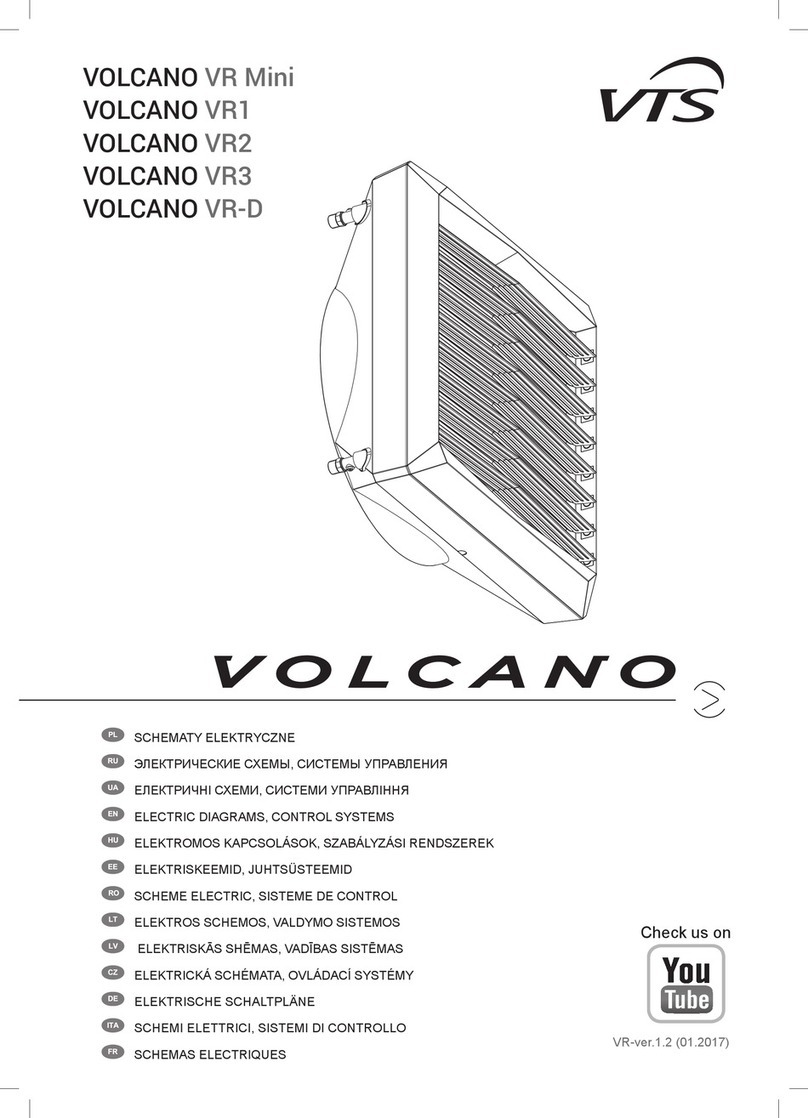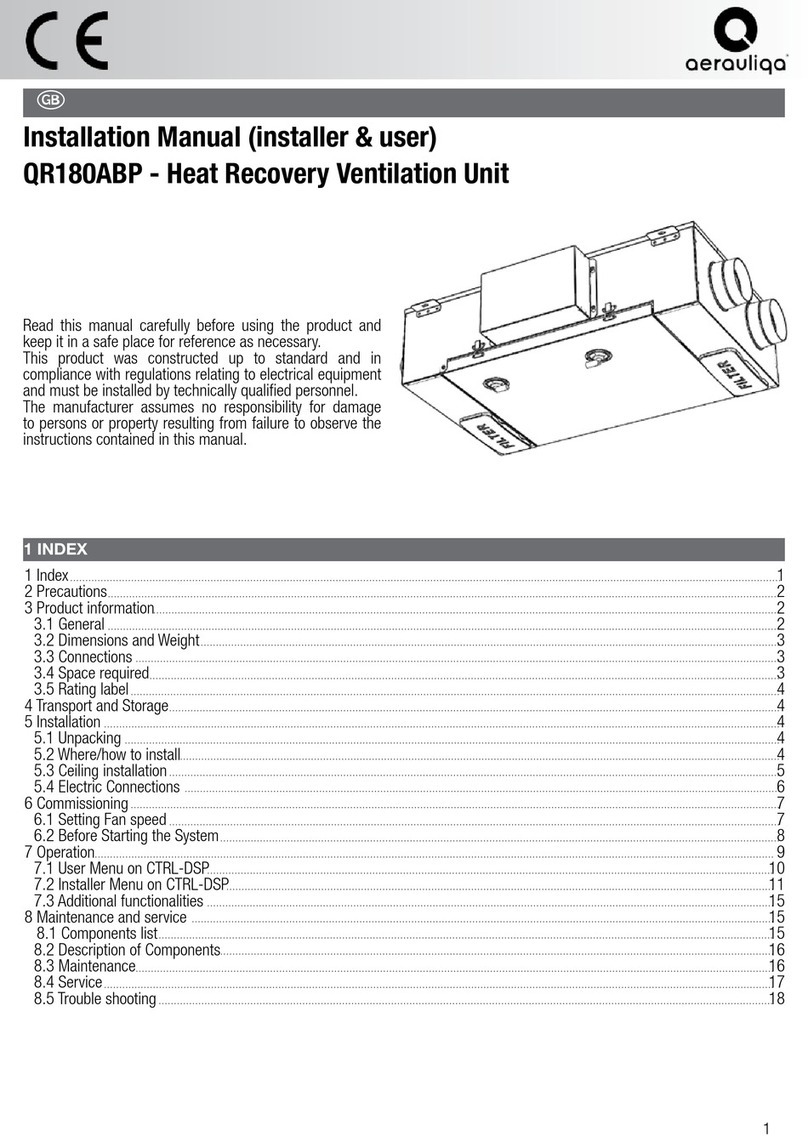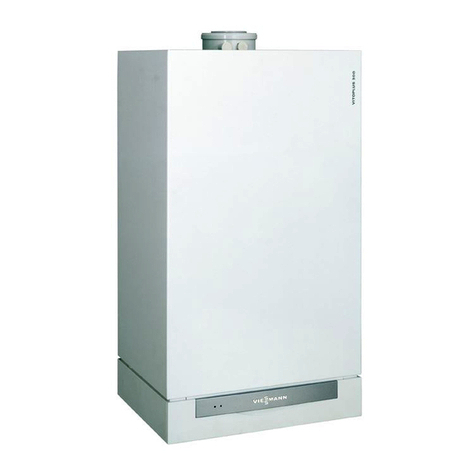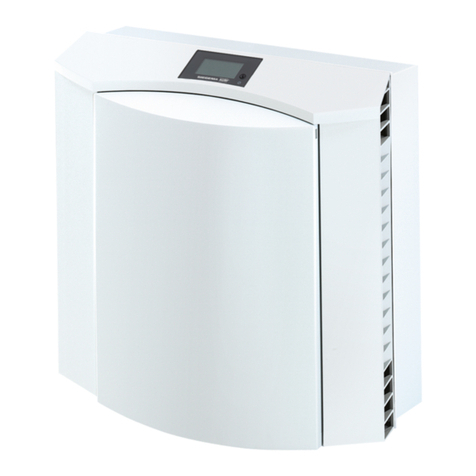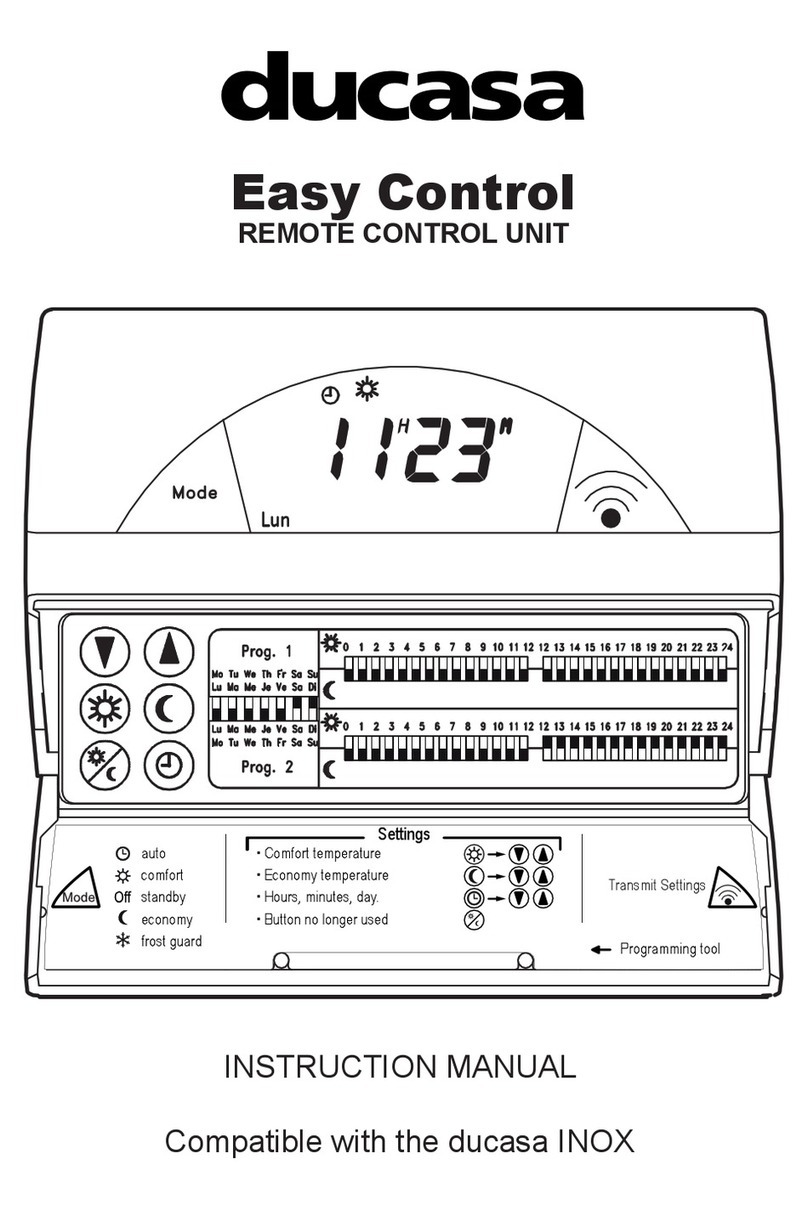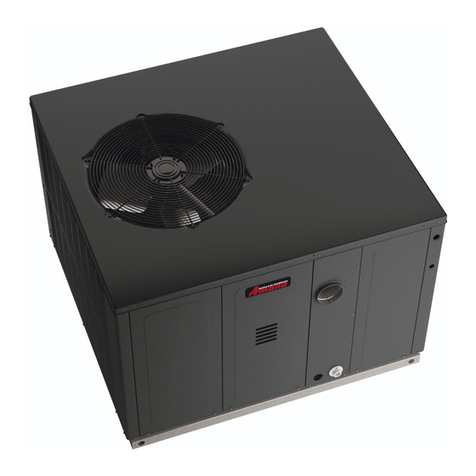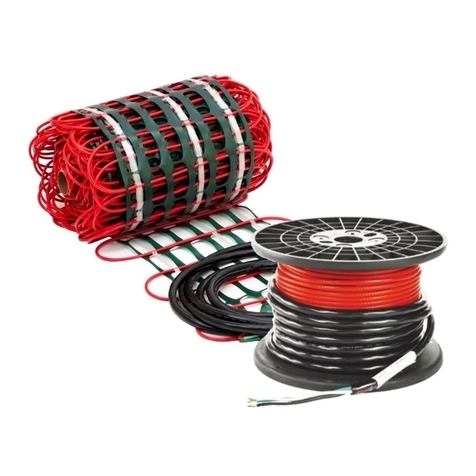Steffes Comfort Plus Hydronic 5120 User manual

V11
OWNER'S AND
INSTALLER'S MANUAL
"Manufactured in North America"
for
COMFORT
PLUS
HYDRONIC
(5100 SERIES)
Models: 5120, 5130, & 5140
Applicable to Software Version 140-159

RECOGNIZETHESE SYMBOLSASSAFETYPRECAUTIONS
Itisimportant,bothforyourpersonalsafetyandtoavoidpossibledamagetothe
equipmentandyourproperty,thatyouobservethesafetyinstructionsgivenfollowing
thesesymbols.
The equipment described herein is intended for installation by a qualified
technician in compliance with applicable local, state, and national codes and
requirements.
To insure proper installation and operation of this product, completely read all
instructions prior to attempting to assemble, install, operate, maintain or repair
this product. Upon unpacking of the system, inspect all parts for damage prior
to installation and start-up.
This manual should be retained by the owner upon completion of the installa-
tion and made available to service personnel as required.
Disclaimer: In compiling this manual, Steffes Corporation has used its best
judgement based upon information available, but disclaims any responsibility
or liability for any errors or miscalculations contained herein, or any revisions
hereof, or which result, in whole or in part, from the use of this manual or any
revisions hereof.
After the heating system is installed, Steffes disclaims any responsibilityor
liability for mold/mildew growth and/or any damages caused by either. We
strongly recommend that the user follow the moisture, mold and mildew pre-
vention guidelines of the Environmental Protection Agency (EPA), available at
http://www.epa.gov.
IMPORTANT
For Customer Use
Please record your model and serial number below. This number is found on the identification label
located on the lower left side of the Comfort Plus Hydronic heating system. Retain this information for
future reference.
Model No. ________________________________________________________________________
Serial No. ________________________________________________________________________

SAFETY PRECAUTIONS
1. DO NOT energize this heating system while
disassembled or without the ceramic heat storage
brick in place.
2. DO NOT operate this heating system without the
factory provided pressure relief valve in place.
3. DO NOT use or store materials that may produce
explosive or flammable gases near the system.
4. DO NOT violate the placement and clearance
requirements specified in this manual. (Page 3.02-
3.03)
5. DO NOT place anything on top of the system.
6. Disconnect power to all circuits before servicing as
this heating system may be connected to more than
one branch circuit.
7. Use caution when working around the heating
system as inlet and outlet piping can be very hot.
8. Installation of and/or service to this system should be performed bya qualified technician in compliance with
information contained herein and with national, state, and local codes and requirements.
9. A repeated message display of “CORE FAIL”indicates a need for service by a qualified technician.
SAFETY DEVICES
The Comfort Plus Hydronic incorporates safety devices to ensure normal operating temperatures are maintained.
The chart below describes these safety devices:
Comfort Plus Hydronic Safety Information
WARNING
Risk of explosion. Can cause injury or death.
Operating the system without the pressure
relief valve installed can cause an explosion.
Connect the pressure relief valve in a vertical,
upright position with the supplied fittings. DO
NOT modify this assembly. DO NOT cap, plug,
or otherwise obstruct the outlet of the pres-
sure relief valve.
Risk of fire. Can cause injury or death. Viola-
tion of the clearance requirements can cause
improper operation of the equipment. Main-
tain the placement and clearance require-
ments specified.
Risk of personal injury. Plumbing and other
surfaces can be hot. Use caution when work-
ing near the system.
DEVICENAME FUNCTION LOCATION
ON SYSTEM
Core Charging High
Limit Switches
(Auto Reset)
These limit switches monitor brick core charging and
interrupt power to the heating elements if the normal
operating temperature is exceeded.
This linear limit switch monitors the temperature of the
water in the exchanger and interrupts power to the core
blower if a water temperature of 250oF is exceeded. If
this limit switch opens, contact a qualified service techni-
cian.
Heat Exchanger
Limit Switch
(Manual Reset)
In the limit bar panel
on the left side of the
brick storage cavity.
Inside base on left side.
This linear limit switch monitors the temperature of the
water in the exchanger and interrupts power to the core
blower if a water temperature of 225oF is exceeded.
Outlet Water
Temperature Limit
Switch (Auto Reset)
Inside base on left side.
Pressure Relief Valve Factory provided,
fieldinstalledtooutlet
port of furnace.
If the water pressure exceeds 30 psig, the pressure relief
valve opens. Once water pressure of less than 30 psig is
achieved, the valve closes.

Operation
GeneralOperation..................................................................................................................................................................1.01
System Use During Construction Phase ...............................................................................................................................1.01
System Start-up .....................................................................................................................................................................1.01
Turning System "OFF" and "ON" .........................................................................................................................................1.01
ControlPanel.........................................................................................................................................................................1.02
Operating Status ...................................................................................................................................................................1.02
RoomTemperatureControl ...................................................................................................................................................1.03
BrickCoreChargeControl.....................................................................................................................................................1.03
ChargeControlOverride .......................................................................................................................................................1.03
Maintenance and Cleaning....................................................................................................................................................1.03
Optional Accessories
SingleElectricalFeedKit .......................................................................................................................................................2.01
PrimaryLoopKit ...................................................................................................................................................................2.01
AirHandler............................................................................................................................................................................2.01
Static Heat Recovery Unit .....................................................................................................................................................2.02
Comfort Plus Stand ...............................................................................................................................................................2.02
Installation
Shipping and Packaging........................................................................................................................................................3.01
Placement andClearanceRequirements ........................................................................................................................ 3.02-3.03
InitialSet-up ..........................................................................................................................................................................3.03
BrickLoading ........................................................................................................................................................................3.04
HeatingElement and Air Channel Installation............................................................................................................... 3.04-3.05
BrickCoreTemperatureSensorInstallation ..........................................................................................................................3.05
LineVoltageElectricalConnections .............................................................................................................................. 3.06-3.07
LowVoltageElectricalConnections
PeakControl........................................................................................................................................................... 3.07-3.08
Outdoor Temperature Sensor ................................................................................................................................. 3.08-3.09
RoomThermostat................................................................................................................................................... 3.09-3.10
Air Conditioner /Heat Pump Interface ...................................................................................................................................3.10
PressureReliefValveInstallation ..........................................................................................................................................3.11
Plumbing ....................................................................................................................................................................... 3.11-3.13
AuxiliaryLoadControl ..........................................................................................................................................................3.13
Configuration Menu...................................................................................................................................................... 3.14-3.15
Installer's Final Check-out Procedure ....................................................................................................................................3.16
Appendix
Specifications...................................................................................................................................................................... A.01
PartsDiagram ...................................................................................................................................................................... A.02
Parts List ..................................................................................................................................................................... A.03-A.04
InternalSystemWiringDiagrams-LineVoltage......................................................................................................... A.05-A.07
InternalSystemWiringDiagram-LowVoltage................................................................................................................... A.08
Help Menu .......................................................................................................................................................................... A.09
ErrorCodes .................................................................................................................................................................A.09-A.10
Disassembling the Comfort Plus Hydronic System ............................................................................................................. A.11
Glossary .............................................................................................................................................................................. A.12
Warranty
Table of Contents Comfort Plus Hydronic
Table of Contents
TC

Comfort Plus Hydronic Operation 1.01
GENERAL OPERATION
The Steffes Comfort Plus Hydronic heating system stores off-peak electricity in the form of heat. Off-peak
electricity is available during times of the day or night when electricity is plentiful and the power company may
supply it at a lower cost.
Operation of the Comfort Plus Hydronic is automatic. When off-peak hours are
available, the system converts electricity to heat which is then stored in its ceramic
brick core. The amount of heat stored in the brick core varies in relation to outdoor
temperature, owner preference, utility peak conditions, and the requirements of the
space being heated.
A heat call from the room thermostat energizes the primary water loop pump. The
variable speed core blower automatically adjusts its speed to achieve the desired outlet
water temperature. The heated water is then pumped to the area (zone) from which
the heat call originated.
The versatility of this system allows it to fit many applications. The Comfort Plus
Hydronic is designed for use as either the sole heating source (“stand alone”furnace)
or as a supplement to ducted heating systems such as heat pumps.
SYSTEM USE DURING CONSTRUCTION PHASE
Like most heating equipment manufacturers, Steffes strongly recommends that “Construction Heating Units”be
used instead of the permanent heating system during the construction phase of a new home. Use of the perma-
nent heating system during the construction phase may contaminate the duct system and/or internal areas of the
heating system. This may cause poor indoor air quality issues and/or improper system operation once the home is
completed. A suitable alternative heating system must be used during the construction phase.
SYSTEM START-UP
On start-up of the Comfort Plus Hydronic system, odors relating to first time operation of the heating components
may be experienced. Allow the system to charge to its maximum brick core charge level, on start-up, to expel
these odors. If the Comfort Plus Hydronic has not been used for an extended period of time, dust may accumulate
in the system. Upon restart, there may also be an odor as these dust particles are expelled.
During operation, the system may produce minor expansion noises. These noises are the result of the internal
components reacting to the temperature changes.
TURNING SYSTEM "OFF" AND "ON"
The Comfort Plus Hydronic element (charging) circuits may be turned “OFF”by switching all of the 60 AMP
breakers located on the front of the electrical panel to the DOWN position. To turn the element circuits “ON”,
switch the 60 AMP breakers to the UP position.
The 60 AMP breakers MUST all be turned "ON" or all turned "OFF". The 15 AMP breaker
MUST remain “ON”to operate controls in the system if:
using the Comfort Plus Hydronic in conjunction with a heat pump or air conditioner.
using the Comfort Plus Hydronic to control other loads.
using the optional Steffes Time Clock Module.
using the Comfort Plus Hydronic to exercise the pumps during periods of inactivity.
Operation
Operation

AM and PM Indicator Lights
The AM and PM indicator lights are only utilized if the Steffes Time Clock Module is
beinginstalled.Withthismoduleinstalled, thesystemdisplaystimeonAM/PM
intervals and the corresponding light flashes. The system can be configured to display
military time, in whichcase, both the AM and PM lights illuminate.
Mode (Edit) Button
Activates the editing menu for changing the operating
information of the system.
Up and Down Arrow Buttons
Used to scroll up and down when viewing or changing
operatingfunctions.
Interface Port
FOR SERVICE USE ONLY! Allows technician external access for updating software and troubleshooting.
Operation 1.02 Comfort Plus Hydronic
CONTROL PANEL
Operation of the Comfort Plus Hydronic system is automatic. All operational functions are stored in its micropro-
cessor in function locations and are factory preset. If necessary, the user or installer can adjust them through the
control panel. (See Figure 1.)
Four-Digit LED Display
The fourdigitLEDdisplaysspecificoperatinginformation. Duringan editing
process, the function locations and the values set in these locations are displayed
forviewingandadjusting purposes.
M
OPERATING STATUS
The Comfort Plus Hydronic is set to display various operating information as described below. Press and release
the up arrow to view this data.
Outdoor Temperature - indicates current outdoor temperature.
Operating Mode and Outlet Water Temperature - indicates the current operating mode
followed by the outlet water temperature.
C = Off-Peak (Charge) Time
P = On-Peak (Control) Time
A = Anticipated Peak Time
Heat Call Status - indicates the current heat call status as determined by the room
thermostat(s). The faceplate displays the highest heat call value present. If receiving a Stage
1 Forced Air Heat Call and a Hydronic Heat Call, the display will read “HC_3”.
HC_0 = No Heat Call HC_1 = Stage 1 Forced Air Heat Call (if equipped with Air Handler)
HC_2 = Stage 2 Forced Air Heat Call (if equipped with Air Handler)
HC_3 = Hydronic Heat Call COOL = Cooling Call (if equipped with Air Handler)
Targeted Brick Core Charge Level - “tL”(target level) followed by a number, indicates
the current percentage of brick core charge being targeted by the system. A display of “tL:_”
indicates a target level of zero percent and “tL: F”indicates a full core charge target level.
Brick Core Charge Level - “CL”(charge level) followed by a number, indicates the
current percentage of heat stored in the brick core. “CL:_”represents zero percent and “CL:
F”represents a full core charge level.
A bar illuminates on the lower portion of the display's third digit when-
ever the heating elements are energized.
Operation
CAUTION
Editing operating information may
alter the performance and opera-
tion of the system.
CONTROL PANEL
FIGURE 1
MM
PP
M
MM
AA

Comfort Plus Hydronic Operation 1.03
ROOM TEMPERATURE CONTROL
Room temperature is adjusted at the wall thermostat(s). A heat call from the room thermostat energizes the
primary water loop pump. The variable speed core blower automatically adjusts its speed to achieve the desired
outlet water temperature. The heated water is then pumped to the area (zone) from which the heat call origi-
nated.
In heat pump applications, a heat call from the room thermostat first utilizes the heat pump’s heating capacity to
satisfy comfort requirements. As the outdoor temperature declines and the heat pump’s heating capacity begins
to diminish, the Comfort Plus Hydronic modulates heat to help maintain a comfortable air temperature in the duct.
BRICK CORE CHARGE CONTROL
The amount of heat stored in the brick core of the Comfort Plus Hydronic system is regulated automatically in
relation to outdoor temperature and the heating requirements. The outdoor sensor, supplied with the system,
monitors outdoor temperature. As the outdoor temperature decreases, heating requirements increase, and the
Comfort Plus Hydronic system stores more heat accordingly.
CHARGE CONTROL OVERRIDE
The Comfort Plus is equipped with a charge control override feature that allows the user to force the system to
target a full core charge level. This override can be initiated or cancelled at any time. If an override is initiated,
the system targets a full core charge level during the next off-peak period. It continues to charge during off-peak
hours until the system achieves full (maximum) core charge or until the override is cancelled. Once full charge is
achieved or the override is cancelled, the system charges according to its standard configuration.
Initiating the Override Feature
Step 1 Press and hold the M, the up arrow, and the down arrow buttons at the same time.
Step 2 The faceplate will flash “FULL”and “ON”. Continue to hold the three buttons until “ON”displays
continuously on the faceplate.
Step 3 Release the buttons. The override is now enabled. The faceplate will return to displaying its standard
operatingmode.
Manual Cancellation of the Override Feature
Step 1 Press and hold the M, the up arrow, and the down arrow buttons at the same time.
Step 2 The faceplate will flash “FULL”and “OFF”. Continue to hold the three buttons until “OFF”displays
continuously on the faceplate.
Step 3 Release the buttons. The override is now cancelled. The faceplate will return to displaying its standard
operatingmode.
MAINTENANCE AND CLEANING
General cleaning of the system's cabinet should be conducted at the user's discretion. It is important to monitor
water levels/pressure (PSI) as low water levels cause poor performance and possible damage to the system. Ask
the installer of the equipment for information on how to measure these levels.
If utilizinga heat pump or airconditioner with the Comfort Plus Hydronic, the indoor coil of these devices should
be cleaned periodically, to maintain system efficiency. Follow the manufacturer's cleaning recommendation for
these devices.
Operation

Optional Accessories
Optional Accessories 2.01 Comfort Plus Hydronic
SINGLE ELECTRICAL FEED KIT
The Steffes Comfort Plus systems have built-in circuit breakers. They are factory
configured to be field connected to multiple line voltage circuits. If single feed to the
elementandblowers/controlcircuitsisdesired,thesinglefeedkitisavailabletoallow
thesystemtobepoweredwithaone,largerlinevoltagecircuit.Contactthefactoryfor
orderingdetails.
When using single feed, the neutral conductor MUST be sized in
accordance with all applicable local, state, and national codes and
regulations.
PRIMARY LOOP KIT
The Comfort Plus Hydronic system requires a primary water loop which serves to regulate heat transfer from the
unit’s heat exchanger. To minimize installation time and costs for field design and engineering of this loop, Steffes
Corporationoffersaprimaryloopkit.Thekitcontainsthecomponentsgenerallyinstalledwithhydronicheatsystems.
Features:
Includes a 5-gallon diaphragm type expansion tank, Grundfos brand pump
(circulator), air separator, air vent, pressure gauge, and pump connection
conduitandfittings.
Contains the appropriate valves to bleed air from the system during filling along
with automatic purge during system operation and draining.
Incorporates isolation flanges for quick and easy servicing of the primary loop
pump(circulator).
Offers troubleshooting isolation between the heating system and secondary
zones.
AIR HANDLER
The Steffes air handler allows the 5100 series heating system to
provide forced air heating or to be interfaced with other ducted heating
and/or cooling systems such as a heat pump or air conditioner. When
used with a heat pump, it serves as the back-up or supplement heat
and provides comfort modulation. It’s duct sensor monitors outlet air
temperature and modulates the off-peak stored heat needed to
maintain the desired output air temperature. As the air handler is
attached to the Comfort Plus system, it also directs the heat lost
statically through the outer panels into the ductwork for delivery to the
living space (automatic static heat recovery). The Comfort Plus
system’s internal controls automatically regulate the air handler’s
operation.
Configurations Available:
½HPwith60,000BTU/hrwatercoil (accommodatesmost1.5to4ton
heating/coolingsystems)
½HP variable speed ECM blower with 60,000 BTU/hr water coil
(accommodates most 1.5 to 4 ton heating/cooling systems)
1 HP variable speed ECM blower with 80,000 BTU/hr water coil (accommodates most 3 to 5 ton heating/
coolingsystems)
Accessories
Order Item #1302100 (1/2 HP)
Order Item #1302104 (1/2 HP VS)
Order Item #1302105 (1 HP VS)
TEFFES
CORPORATION
S
OrderItem#1302115

STATIC HEAT RECOVERY UNIT
During operation of the Comfort Plus Hydronic system, some heat from the brick
core storage will radiate through its outer panels. If the system is located in an
area with minimal heating requirements, such as a utility room, the static heat
recovery unit can maximize the system’s efficiency by transferring this static heat
to a more desirable location.
Features:
Connects directly to the Comfort Plus Hydronic system to interface with the
internal controls of the system for automatic operation.
Specifications:
•Wattage: 130 WATTS
•Motor: .1 HP, 60 HZ
•Voltage: 208/240 VAC
•Maximum Static Pressure: .15 inches Water Column
•CFM @.15 SP: 130 CFM
NOTE: In applications using the Steffes Air Handler, the static heat recovery unit would not be used.
If the area available to install the Comfort Plus Hydronic system is less than 100 square feet, Steffes Corpora-
tion recommends installing a low voltage cooling thermostat, connected between R and G on the 12-position
terminal block, to maintain a temperature less than 85 degrees Fahrenheit.
COMFORT PLUS STAND
Some applications (such as garages) may require that the heating appliance be elevated in order to meet building
codes. The Steffes Comfort Plus stand elevates the 4100 or 5100 series Comfort Plus system 18". This stand is
shipped as a kit and requires field assembly.
7.875
10.072
10.135
3.000
3.312
ManualReset
LimitSwitch
OrderItem#1302110
Accessories
Comfort Plus Hydronic Optional Accessories 2.02
Stand
Stand
Order Item #1301585

Installation
SHIPPING AND PACKAGING
The Comfort Plus Hydronic should always be transported in an upright position to avoid damage to internal
components and insulation materials. The information below describes the items shipped with each system:
Installation
CAUTION Risk of sharp edges. Can cause personal injury. Use caution
when installing and/or servicing equipment.
4
(shipped inside the electrical
compartment)
Refer to Pages 3.08-3.09
3OUTDOOR
TEMPERATURE SENSOR 5
ELEMENT SCREW KIT
(shipped inside the
electrical compartment)
Refer to Pages 3.04-3.05
PRESSURE RELIEF VALVE KIT
7
(shipped behind the exchanger
access panel)
Refer to Page 3.11
JUNCTION BOX
(shipped behind the
exchanger access panel)
See Figure 9, Page 3.07
1INFORMATION PACKAGE
(includesOwner'sManualand
WarrantyRegistrationCard)
(adhered to outer side of
shipping box)
(shipped inside the brick core)
Refer to Pages 3.04-3.05
2
MODEL ELEMENTS
5120 8
5130 12
5140 16
HEATING ELEMENTS
CERAMIC BRICK
6
Full Brick
(shipped separately
and packaged 4 brick
per box)
Half Brick
(shipped with brick and
packaged in a white box
consisting of 6 half brick
and 1 full brick)
Model Full Brick HalfBrick
5120 26Boxes 1Box
5130 37Boxes 2Boxes
5140 49Boxes 2Boxes
See Figure 4, Page 3.04
Installation 3.01 Comfort Plus Hydronic

TOP VIEW
3" REQUIRED
CLEARANCE
36" REQUIRED CLEARANCE
FRONT VIEW
6" REQUIRED CLEARANCE
36" REQUIRED
CLEARANCE
3" REQUIRED
CLEARANCE
P
M
M
A
36" REQUIRED
CLEARANCE
ELE CT RIC TH ER MA L S TORA GE
TEFFES
S
M
TEFFES
S
3" REQUIRED
CLEARANCE
1" REQUIRED
CLEARANCE
PLACEMENT AND CLEARANCE REQUIREMENTS
The physical dimensions (Figure 2) of the Comfort Plus Hydronic
along with the clearances required (Figure 3) MUST be taken
intoconsideration whenchoosingits locationwithin astructure.
The best installation location for this system is in a space requir-
ing heat, so some amount of the heating requirements can be
satisfied through static dissipation from the warm outer panels of
the system. Standby heat dissipation of up to 2.5kW can be
experiencedinnormaloperation.
The minimumarea required for the installation of a Comfort Plus
Hydronic is 100 square feet. This area must remain free of
debris and room air should be maintained at less than 85°Fahr-
enheit. If the system is being installed in an area with less than
400 square feet, ventilation MUST be provided. If the area
available to install the system is less than 100 square feet, consult
the factory.
MINIMUM CLEARANCE REQUIREMENTS
Back and Right Side = 3 inches (from combustible material)
Bottom = 1 inch clearance
Top = 6 inches (from combustible material)
Front = 36 inches (for ease in servicing)
Left Side = 36 inches (for ease in servicing)
5100 SERIES REQUIRED CLEARANCES
FIGURE 3
5100 SERIES DIMENSIONS
FIGURE 2
Installation
Minimum clearance requirements do NOT account for space needed for making electrical con-
nections. If utilizing, the Air Handler, an additional 23 inches is required on the right hand side of
the system.
Comfort Plus Hydronic Installation 3.02
OutletInlet
5140
68 58"
5130
57 58"
5120
46 58"
29 3
16"
47 5
16"
Front View
WARNING
Risk of fire. Can cause injury or death.
Violation of the clearance require-
ments or failure to provide proper
ventilation can cause improper
operation of the system. Maintain
the placement and clearance
requirements as specified and
provide ventilation as necessary.
Moving the system after install
may result in equipment damage.
Do NOT move system from origi-
nal installed location.

If the Comfort Plus Hydronic is installed in an area where radiant heat coming from the system is undesired or
where room temperatures may reach 85°Fahrenheit or greater, it is strongly recommended to install a Static Heat
Recovery unit or Air Handler. Refer to page 2.01 for information on these options.
In addition to the physical space requirements, the weight of the Comfort Plus Hydronic must be taken into consid-
eration when selecting the installation surface. A level concrete floor is the best installation surface, but most well
supported surfaces are acceptable. If unsure of floor load capacity, consult a building contractor or architect.
Special requirements need to be considered if placing the system in a garage or other area
where combustible vapors may be present. Consult local, state, and national codes and regula-
tions to ensure proper installation. An 18" stand (Order Item #1301585) is available to elevate
the system.
INITIAL SET-UP
Step 1 Remove the Information Package from the outside of
the shipping box and unpackage the Comfort Plus
Hydronic heating system.
Step 2 Movetheheatingsystemintoitsinstallationlocation.
The Comfort Plus Hydronic is capable of fitting through
a 30"doorway (minimum)without disassembling. Ifit
is necessary to disassemble the system, refer to the
disassembly instructions (Page A.11) inthis manual.
Step 3 Once in place, adjust the leveling legs on the bottom of
the system as necessary to prevent rocking. If not
placed properly the system may bend or twist during the
brick loading process, making element and brick core
temperaturesensorinstallationdifficult.
Step 4 Remove the painted front panel of the brick storage
cabinet by removing the sheet metal screws along the
top, bottom, and sides of the panel. Detach by pulling
the bottom of the panel forward and down.
Step 5 Locate the element wiring harnesses and brick core temperature sensor(s) behind the front panel and
disconnect themfromtheirshippingposition. Carefullyposition themtoavoiddamageduringbrick
loading.
Models 5130 and 5140 have two brick core temperature sensors.
Step 6 Remove the galvanized front panel and set it aside.
Step 7 Carefully lift the two insulation blankets, one at a time starting at the bottom, and drape them over the
top of the system.
Use face mask, gloves, and long sleeved garments when handling insulation materi-
als in compliance with generally accepted safety practices.
Step 8 Remove the front air channel by pulling out at the top.
Step 9 Remove the heating elements from inside the brick core cavity.
To ensure proper operation, read and
follow installation instructions carefully.
DO NOT install the Comfort Plus
Hydronicsystemonitsshipping
pallet.
DO NOT extend the leveling legs
more than one inch.
DO use and follow generally
accepted safety practices when
handling insulation material.
DO have equipment installed by a
qualified technician in compliance
with all applicable codes and
regulations.
IMPORTANT
Installation
Installation 3.03 Comfort Plus Hydronic

FrontofUnit
Notch in Brick
HALF BRICK
5120: Load in row 5
5130: Load in row 4 and 8
5140: Load in row 6 and 12
BRICK LOADING
FIGURE 4
BRICK LOADING
Load the brick, one row at a time, using a left side, right
side, center pattern. Start at the back of the brick core and
work forward. Make sure the brick are placed so the
grooved side is facing up, the notch is facing forward, and
the ridges are on the left and right. (See Figure 4.)
BRICK INSTALLATION TIPS:
•Install bricks carefully to avoid damage to the
insulationpanels.
•Remove loose brick debris to prevent uneven
stacking of brick, as this can make installation of the
elements and the brick core temperature sensor(s)
difficult.
•Brick rows MUST line up front to back and side to
side.
•Half brick makes brick loading easier by evening
out the stacks. Use HALF BRICK (white boxes)
in the proper rows and positions as indicated in Figure 4. The back half of the brick MUST be installed in
the back row and the front half (the notched brick piece) MUST be installed in the front row.
Risk of fire. Can cause personal injury or death. DO NOT operate the Comfort
Plus Hydronic system if damage to the insulation panels on the inner sides of
the brick core occurs.
WARNING
HEATING ELEMENT AND AIR CHANNEL INSTALLATION
Step 1 After all brick are loaded, insert the heating elements between the brick layers, sliding them in until the
element ends embed into the side cutouts of the brick cavity. Elements MUST be installed with the
threaded screw tabs on the wire connection terminals pointing
forward and down to ease the installation of the element-to-
wiring harness. Note the required clearance (Figure 5.)
ELEMENT INSTALLATION
FIGURE 5
3
4"
Required Clearance Between
Element Termination and Metal
Panels is 1/2" (3/4" Nominal)
Element Connection
TOP VIEW
Installation
Comfort Plus Hydronic Installation 3.04
HAZARDOUSVOLTAGE:Risk
of electric shock. Can cause
injury or death.
DO NOT remove the electri-
cal panel cover while
system is energized.
Position elements properly
to avoid short circuiting
them against metal sur-
faces.
Protect element lead wires
from front panel screws
and any field installed
screws to avoid short
circuit.
WARNING

BRICK CORE TEMPERATURE SENSOR INSTALLATION
Step 1 Remove the screw(s) around the brick core temperature sensor
hole(s) in the galvanized front panel.
Models 5130 and 5140 have an upper and a lower brick
core temperature sensor.
Step 2 Insert the brick core temperature sensor(s) through the hole(s) in the
galvanized front panel. If installing a system with two sensors, be
sure the one marked as the upper sensor is installed in the upper
position and the one marked as the lower sensor is installed in the
lower position. The sensor(s) must pass through the blanket insulation
and into the brick core. Holes have not been pre-drilled through the
insulation. Use the sensor(s) to aid in making a passageway by
rotating the sensor(s) side-to-side while gently pushinginward.
Step 3 Once the brick core sensor(s) is installed, put the screw(s) back into position in the galvanized front
panel to hold the sensor(s) in position and to provide the electrical ground.
Step 4 Check the non-insulated element terminations to make sure they do not come within 1/2" of any surface
area on the system.
Step 5 Re-install the painted front panel, using the previously removed screws.
CAUTION
Risk of improper opera-
tion. Proper installation of
the brick core tempera-
turesensor(s)iscriticalto
the operation of the
ComfortPlusHydronic
heating system. Read and
follow installation instruc-
tions carefully.
Step 2 Install the front air channel by placing
the bottom in first, with the air deflec-
tors (arrow shaped pieces) facing
inward. Refer to the Air Channel
Placement (Figure 6) and the Parts
Diagram (Page A.02) for proper
placement and installation of the front
air channel.
Step 3 Lower the insulation blankets back into
position, one at a time. Carefully tuck
thesidesof this insulationinto the
edges, corners, and around the exposed
portions of the heating element to
ensure maximumefficiency.
Step 4 Reinstall the galvanizedfrontpanel by
sliding the bottomof the panel inside the
lower lip of the brick cavity and resting
the top of the panel on the outside of the
brick cavity. Secure it to the Comfort
Plus Hydronic system using the screws that were originally removed.
Step 5 Remove the painted front panel of the electrical compartment by removing the screws along the
edges. Locate the installation hardware package that is shipped in this compartment.
Step 6 Carefully route the element wiring harnesses and connect them to the heating elements, using the
screws provided in the hardware package. Connections should be made with the screw heads up and
the threads pointing down. Element screws should be tightened to 14 inch lbs. Refer to Figure 5 for
properpositioning.
AIR CHANNEL PLACEMENT
FIGURE 6
Electrical
Panel
Front Air
Channel
BRICK
CORE
SIDE VIEW
Outlet
Inlet
Installation
Installation 3.05 Comfort Plus Hydronic

LINE VOLTAGE ELECTRICAL CONNECTIONS
In standard configuration, the Comfort Plus
Hydronic is wired for connection to 240V,
however, the element circuits can also be
connected to 208V. A 208V connection derates
the charging input of the system by 25%. If a
system rated specifically for 208V or 277V is
required, contact the factory. The controls
circuit in the Comfort Plus Hydronic system
MUST be connected to 120V/240V or 120V/
208V. If connecting to 120/208V, contact the
factoryforprogramminginformation.
The 60 amp breakers located in the electrical
compartment on the Comfort Plus Hydronic
feed the core charging (element) circuits. The
15 amp breaker feeds the controls, blowers, and
pumps circuit. All Comfort Plus Hydronic
systems are factory configured to be field
connected to multiple line voltage circuits. If a
single feed line voltage circuit is desired, an
optional singlefeed kitisavailablefromthe
factory.
To determine the correct wire size required for
each circuit feeding the Comfort Plus Hydronic,
refer to the Specifications (Page A.01) and the
system'sidentification label(Figure 7) located on
the lower left side of the Comfort Plus Hydronic
system.
Step 1 Remove the electrical panel cover.
Step 2 Route all line voltage wires through a
knockout andinto the electrical panel of
the Comfort Plus Hydronic.
Step 3 Make proper field wiring connections to
the Comfort Plus Hydronic breakers.
Refer to the Line Voltage Wiring
Diagrams (Pages A.05-A.07) for more
informationontheseconnections.
To ensure proper operation and safety,
all line voltage circuits must be segre-
gated from low voltage wiring in the
ComfortPlusHydronic.
To reduce electro magnetic fields
associated with electrical circuits and
to avoid induced voltage on sensors
and electronic devices, the circuit
phases MUST be alternated as shown
in Figure 8.
IMPORTANT
HAZARDOUS VOLTAGE: Risk of electric shock. Can
cause injury or death.
•DO NOT energize the system until installation is
complete.
•DO NOT operate the Comfort Plus Hydronic
heating system without the factory supplied
junction box in place. Connections to the primary
loop pump MUST be made inside the junction
box. If installing the optional air handler, the air
handler pump connections MUST also be made
in the junction box.
•Equipment must be installed by a qualified
technician in compliance with all applicable local,
state, and national codes and regulations.
WARNING
Installation
Comfort Plus Hydronic Installation 3.06
Comfort Plus Hydronic
Circuit Breakers
LINE 2
LINE 1
LINE 2
LINE 1
CHARGE CIRCUIT #3
CHARGE CIRCUIT #2
CHARGE CIRCUIT #1
CONTROLS CIRCUIT
CHARGE CIRCUIT #4
(MODEL 5130 and 5140 ONLY)
LINE 2
LINE 1
LINE 1
LINE 2
LINE 1
LINE 2
To Service (Breaker) Panel
NEUTRAL CONNECTION FOR CONTROL CIRCUIT
THIS MUST BE A 120/240V OR 120V/208V CIRCUIT
NEUTRAL
LUG
SAMPLE SYSTEM IDENTIFICATION LABEL
FIGURE 7
CIRCUIT PHASING CONNECTIONS
FIGURE 8
NOTE: The controls
circuit MUST
include a
neutral wire.

6-PositionLowVoltageTerminalBlockCoding
RP = PeakControlInputCommon
P = Peak Control Input
AP = Anticipated Peak (Pre-Peak) Control Input
COM = PeakControlOutputCommon
NC = PeakControlOutput(NormallyClosed)
NO = PeakControlOutput(NormallyOpen)
JUNCTION BOX INSTALLATION
Step 1 Attach the factory supplied junction box to the left side of the Comfort Plus Hydronic system as shown
in Figure 14 (Page 3.12).
Step 2 Make connections to the
primarylooppumpand
airhandlerpumpinside
this junctionbox. The red
and white wires connect
to the primaryloop pump
and the black and white
wires connect to the air
handler pump. (See
Figure 9.) The maximum
connected amperage on
either of these circuits is
1.2 amps.
Step 3 Attach the junction box cover using the screws provided.
If utilizing the optional air handler, the orange wire can be used with the white wire to power a
secondary pump for hydronic zones.
LINE VOLTAGE WIRING DIAGRAM
FIGURE 9
Element 4
Element 3
Element 1
Element 2
Element 8
Element 6
Element 5
Element 7
HEATING ELEMENTS
TRANSFORMER
240v 24v
75VA
LIMIT
CORE
LIMIT
CORE
To Opti onal Static
Heat Reco very System
To Optio nal Air Handler
ToTo
3,5,7
RelaysRelays
2,4,6
To
1, 8
Relays
RED
BLACK
BLUE
250 °
WHITE COM.
Red & W hite To
Prima ry Loo p Pump
(Max 1 .2 AMPS)
Black & W hite
To Air Ha ndler Pump
(Max 1 .2 AMPS)
N.C.
225 °
N.C.
EXCHANGER
LIMITS
BLACK HIGH
CORE BLOWER
GROUND BAR
4uf
Cap.
These wires are located in the lower left
corner of the electrical compartment.
Red & White To
Primary Loop Pump
(Max 1.2 AMPS)
Black & White To Air Handler
Pump (Max 1.2 AMPS)
75°C or higher for field connections of this device.
Use copper or aluminum conductors rated at
Wiring Diagram 240/208 Volt
5120 Line Voltage
LOW VOLTAGE ELECTRICAL CONNECTIONS - PEAK CONTROL
Steffes ETS heating equipment may be controlled by the Power Company via
a peak control signal. This signal can be sent to the equipment using a Steffes
Power Line Carrier control system, low voltage wiring, a Steffes Time Clock
Module,orlinevoltagecontrol. Inapplicationsutilizingautomaticcharge
control, outdoor temperature information is required and can be received via
an outdoor sensor or power line carrier control system.
The Comfort Plus Hydronic system is factory configured for low voltage peak
control and is set to charge when the utility peak control switch closes. Refer
to the Configuration Menu (Pages 3.14-3.15) for information on configuring
the system for the application.
LOW VOLTAGE (HARD WIRED) PEAK CONTROL
If using the low voltage peak control option, the Comfort Plus
Hydronic is direct wired to the power company's peak control
switch. Field connections from the peak control switch are
made to the low voltage terminal block through a low voltage
knockout located on the left side of the electrical panel.
Step 1 Route a low voltage circuit from the power
company’s load control or peak signaling device to
thesix(6)positionlowvoltageterminalblockinside
the electrical compartment of the Comfort Plus
Hydronic system through one of its low voltage wire
knockouts.
Step 2 Connect the field wiring to positions "RP" and "P"
onthe six (6)position lowvoltageterminalblock.
(See Figure 10.)
To use the Comfort Plus to control
other loads, refer to Auxiliary Load
Control (Page 3.13).
Low voltage wires
MUST never enter any
line voltage enclosure.
IMPORTANT
Installation
Installation 3.07 Comfort Plus Hydronic
PEAK CONTROL TERMINAL
CONNECTIONS
FIGURE 10
To Dry Contact Peak
Control Switch
NO
AP COM
RP P NC

POWER LINE CARRIER (PLC) PEAK CONTROL
The Steffes Power Line Carrier (PLC) control system has the ability to communicate with the Comfort Plus
Hydronic system through the existing electrical circuits in the structure. With the power line carrier option, hard
wired low voltage connections from the power company's peak signaling switch connect directly to the transmit-
ting device. The switch signals peak control times to the transmitter, the transmitter sends the signals to the
Comfort Plus Hydronic system, which receives this information and responds accordingly.
Inadditionto providingpeakcontrol signals, thetransmitteralsoprovidesoutdoortemperatureinformation for
automatic charge control, room temperature set back, and anticipated peak utility control signals (if applicable).
The PLC control is optional and must be ordered separately. If utilizing a PLC system, an Owner's and
Installer's manual will accompany the transmitting device. Refer to this manual for information on the installation
and operation of the power line carrier control system.
TIME CLOCK MODULE PEAK CONTROL
The Steffes Time Clock Module is another option for providing a peak control signal to the Comfort Plus Hy-
dronic. It mounts inside the system’s low voltage electrical compartment and interfaces with the relay board via
an interface cable. Peak control times must be programmed into the system once the module is installed to
enable the time clock feature. Refer to the instructions provided with the Time Clock Module for more informa-
tion onthe installationandoperation ofthisdevice.
LINE VOLTAGE PEAK CONTROL
Line voltage control is also an option, but is not the preferred method of control as it is usually more complex and
expensive. If line voltage control is utilized, the controls circuit must be powered with an uninterrupted circuit.
An external switching device, such as a relay panel, is necessary to directly control the heating element charging
circuits. If relying on this method of control, the faceplate on the system MUST continuously display a brick
core operating mode of “C”(charge) regardless of whether it is an off-peak or on-peak period. Refer to C005 of
the Configuration Menu for proper settings. (Reference Pages 3.14-3.15.)
LOW VOLTAGE ELECTRICAL CONNECTIONS - OUTDOOR
TEMPERATURE SENSOR (REQUIRED)
Installation Methods: A) Hard wired to system to the "OS"
and"SC"terminals(default)
OR
B) Connected to Power Line Carrier
(PLC)
Theory of Operation: Theoutdoor sensor monitorsoutdoor
temperature and provides this infor-
mation to the system. The system responds by automatically storing heat in its brick
core according to outdoor temperature and the heating requirements.
Location of: The outdoor sensor must be placed in a location where it can accurately sense outdoor tempera-
ture and is not affected by direct sunlight or other abnormal temperature conditions.
IMPORTANT
If connecting to the Steffes power line
carrier (PLC) system, follow the instal-
lation instructions in the PLC system's
Owner's and Installer's Guide.
Installation
Comfort Plus Hydronic Installation 3.08

LOW VOLTAGE CONNECTIONS
HEAT PUMP APPLICATION
FIGURE 11
Comfort Plus Hydronic 12 Position Low Voltage Terminal Block Coding
R = LowVoltageHot
C = Low Voltage Common
Y = Compressor/Stage 1 Heat Call
W = Stage 2 Heat Call
Y2 = Compressor Output
G = FanCall
O = Reversing Valve Input
O2 = Reversing Valve Output
H= Hydronic Heat
OS = Outdoor Temperature Sensor
SC = TemperatureSensorCommon
DS = Duct Temperature Sensor
Wiring: Route low voltage wire from the outdoor
sensor to the electrical compartment
through one of the low voltage wire
knockouts.
Connect to "OS" and "SC" as shown in
Figure11-13.
If the sensor wiring is routed through an
external wall, the opening through which the wire is routed MUST be sealed. Failure to
do so may affect the accuracy of the outdoor temperature sensor.
The outdoor sensor is supplied with a lead length of 40 ft. If a greater wire length is
needed, it can be extended to a total of 250 ft.
No other loads can be controlled or supplied through this cable. It is for connection of the
outdoor sensor ONLY.
This low voltage cable MUST not enter any line voltage enclosure.
Unshielded Class II (thermostat) wire can be used as extension wire provided it is segre-
gated from any line voltage cabling.
LOW VOLTAGE ELECTRICAL CONNECTIONS - ROOM
THERMOSTAT
A low voltage (24VAC) room thermostat is required for room temperature control with the Comfort Plus Hy-
dronic system. Steffes recommends using a digital thermostat. If utilizing a mechanical thermostat, a load resistor
may be necessary due to the low current draw (.01 amps) on the heat call input circuit of the Comfort Plus
system. Contact the factory for information on thermostats available from Steffes.
IMPORTANT
Outdoor sensor wire MUST NEVER be
combined with other control wiring in a
multi-conductor cable.
12 Position Terminal Block
H
Y2
RYC O O2G W
Optional Freeze Protection
RSOS SC
Room Sensor
Honeywell TH5220D
AuxEL CG O/B
Hydronic Heat Thermostat, Zone
Valve, End Switch, or Pump Control W
RY R
c
R
C - Low Voltage Common
Outdoor Sensor
R - Low Voltage Hot
O - Reversing Valve
Y - Compressor
To Heat Pump
Installation
Installation 3.09 Comfort Plus Hydronic
Low voltage wires MUST never enter
any line voltage enclosure.
IMPORTANT

LOW VOLTAGE CONNECTIONS
CONVENTIONAL FURNACE APPLICATION
(SHOWN WITH UNCONTROLLED AIR CONDITIONING SYSTEM)
FIGURE 12
•If installing a mechanical thermostat or thermostat with anticipator, a resistor kit is
required (Order Item #1190015).
•Airconditionercontrolusingtheoutputcontrolconfiguration(Page3.15)doesNOT
workworkwiththeaboveapplication.
HO O2 RSOS SCGYC W
R Y2
12 Position Terminal Block
R
TH5110D
G
W
C
Y
Honeywell
R
c
C
Y
Optional Freeze Protection
Room Sensor
Outdoor Sensor
(If being used in the application)
Air Conditioner Connections
Hydronic Heat Thermostat, Zone
Valve, End Switch, or Pump Control
R W
AIR CONDITIONER/HEAT PUMP INTERFACE
The Comfort Plus Hydronic system can be used in conjunction with an air conditioner or a heat pump. Refer to the
optional Air Handler (Page 2.01) and the Low Voltage Connections for Heat Pump Application Diagram (Figure
11), for more information on interfacing these systems with the Comfort Plus Hydronic. If multiple heat pumps are
being interfaced, contact Steffes Corporation.
H SC
Hydronic Heat Thermostat, Zone
Valve, End Switch, or Pump Control
R W
Outdoor
Sensor
DS
Comfort Plus Hydronic 12 Position Terminal Block
R C Y2Y G O O2 WOS
LOW VOLTAGE CONNECTIONS
HYDRONIC HEATING SINGLE ZONE SYSTEM
FIGURE 13
Installation
Comfort Plus Hydronic Installation 3.10

PLUMBING
The Comfort Plus Hydronic heating system MUST be plumbed with a primary loop and secondary
(zone) loops. The primary loop needs to consist of a minimum of 10' of 1" pipe and requires its own pump*
(circulator). The secondary (zone) loops require additional pump(s) to operate effectively. Refer to Typical Primary
Loop (Figure 14) and the Typical System Plumbing Diagrams (Figures 15 and 16) for installation information.
The primary loop serves to regulate heat transfer from the system’s heat exchanger and must be powered by
Comfort Plus Hydronic control system as shown in Figure 14.
Step 1 Remove the exchanger access panel and locate the pressure relief valve assembly.
Step 2 Connect the pressure relief valve to the outlet water port on the left side of the Comfort Plus Hydronic.
Itis extremely important that the following conditions for installation of this part are met:
Ensure all connections, including the valve inlet are clean and free from any foreign material.
Use pipe compound sparingly, or tape on external threads only.
Mount the pressure relief valve in a vertical, upright, position directly to the outlet water port of
the system. Under no circumstances should there be a flow restriction or valve of any type
between the safety relief valve and the pressure vessel.
Step 3 Use schedule 40 pipe to install a discharge line
for the pressure relief valve. This discharge line
MUST:
be connected from the valve outlet with no
intervening valve and directed downward
to a safe point of discharge.
allow complete drainage of both the valve
and the discharge line.
be independently supported and securely
anchored to avoid applied stress on the
valve.
be as short and straight as possible.
terminate freely to atmosphere where any
discharge is clearly visible and is at no risk of freezing.
terminate with a plain end that is not threaded.
be constructed of a material suitable for exposure to temperatures of 375oF or greater.
be, over its entire length, of a pipe size equal to or greater than that of the valve outlet.
WARNING
Risk of explosion. Can cause injury or death. The factory supplied
pressure relief valve MUST be connected to the system with the
supplied fittings.
DO NOT modify this assembly.
DO NOT cap, plug, or otherwise obstruct the outlet of the
pressure relief valve.
DO mount the pressure relief valve in a vertical, upright
position.
This pressure relief valve is sized to service the needs of the Comfort Plus Hydronic
heating system. If multiple heating systems are being used, pressure relief valving for
the other system MUST be provided separately.
PRESSURE RELIEF VALVE INSTALLATION
Risk of discharged hot water and/or
steam. Can cause personal injury or
property damage. During operation,
the pressure relief valve may dis-
charge large amounts of steam and/or
hot water. To reduce the potential for
bodily injury or property damage,
install a discharge line.
CAUTION
Installation
Installation 3.11 Comfort Plus Hydronic
Other manuals for Comfort Plus Hydronic 5120
1
This manual suits for next models
2
Table of contents
Other Steffes Heating System manuals
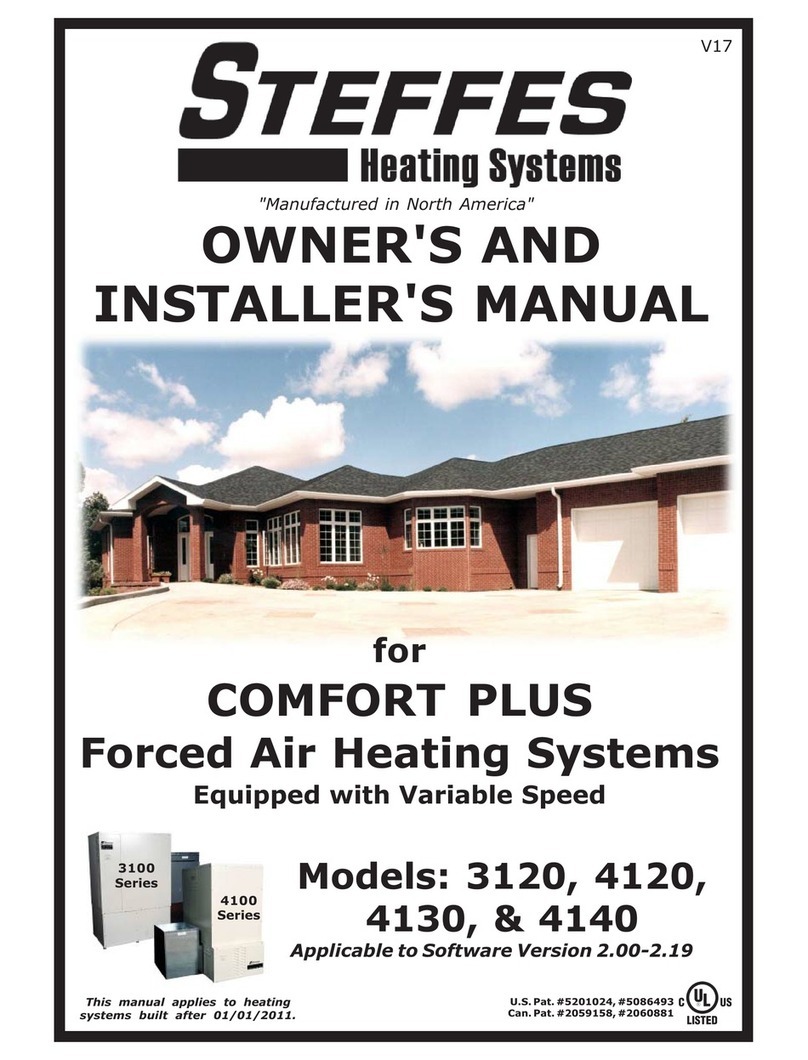
Steffes
Steffes 3100 Series User manual

Steffes
Steffes Comfort Plus Commercial 6140 User manual
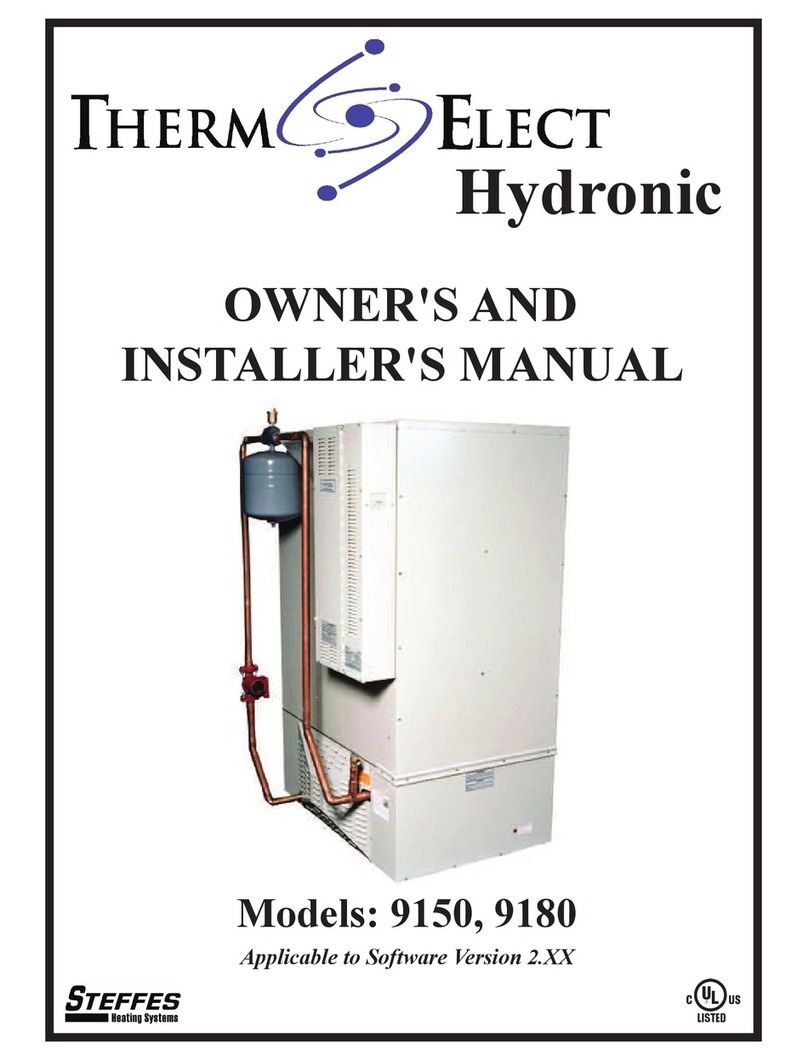
Steffes
Steffes ThermElect Hydronic 9150 User manual
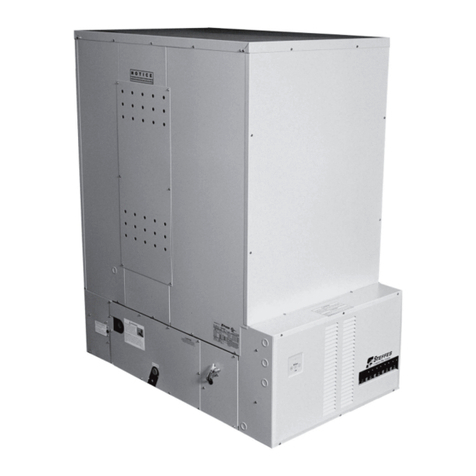
Steffes
Steffes 5120 User manual
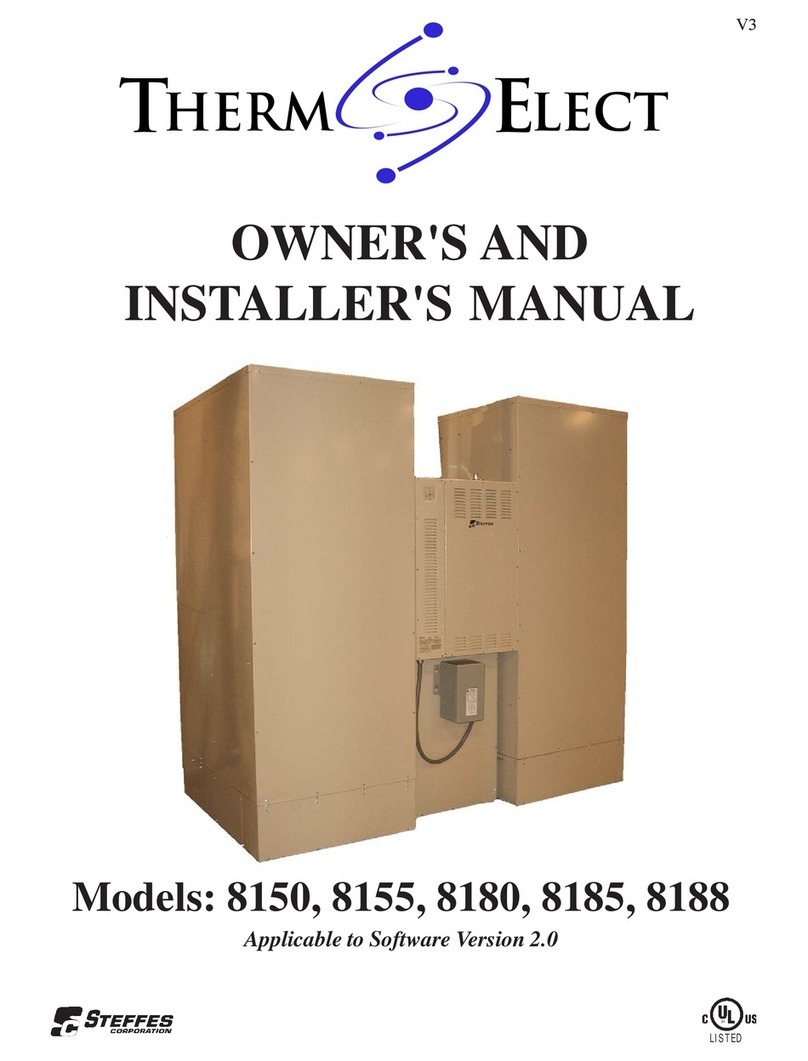
Steffes
Steffes ThermElect 8150 User manual

Steffes
Steffes 212EXT User manual
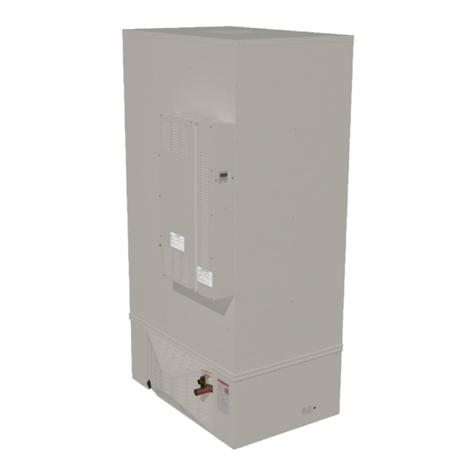
Steffes
Steffes ThermElect Hydronic 9150 User manual
